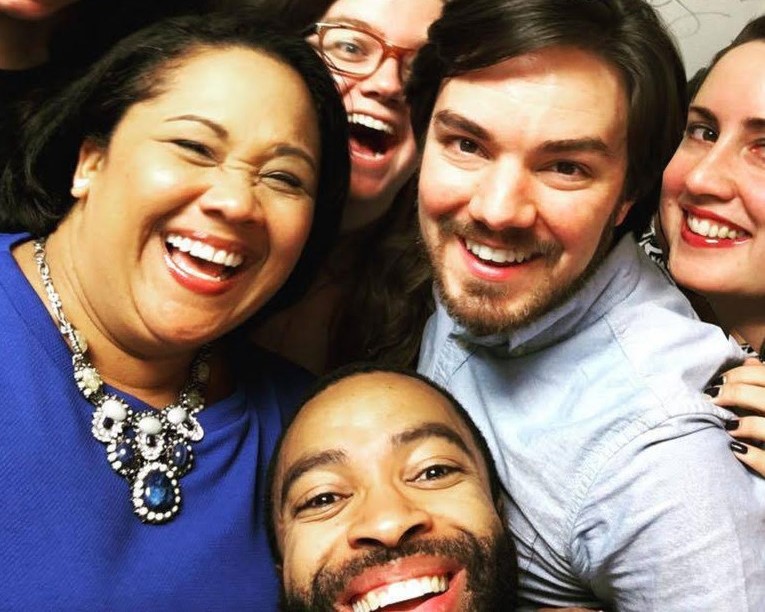Setting the Scene
Way back in 2019, I took a series of Improv classes at a place called Happier Valley Comedy where I live in Western Massachusetts. How brave of me, right? On Tuesday nights a group – ages 15 to 65 – that started out as strangers would gather to engage in a smorgasbord of improvisational games and activities.
The classes were described as a place to “explore your authentic, positive voice in a supportive, nurturing environment grounded in the tenets of improvisation – agreement, acceptance, joy, ease, and play.” In contrast to many hours of my day where I swim in the world of trauma, I was smiling and uproariously laughing for 90 minutes.
It was a great reminder that laughing is great for your parasympathetic nervous system – the part of your nervous system responsible for calming, soothing, and rest.
We also spent the time exploring spontaneity, risk-taking, play, and what gets in the way of allowing those qualities to shine through; it usually has to do with self-criticism, self-consciousness, and self-worth. I learned that through improv you can learn how to watch, deescalate, and befriend the self-critical voice that so often runs constantly in our heads. We practiced actively letting joy emerge!
Making the Connection
As a long-time trainer of Risking Connection, I also immediately thought of how great these activities would be for trainings. They could be used as ice-breakers at the beginning of a training, energy boosters when you see your attendees' eyes glaze over teaching the RC Trauma Framework, or as a stand-alone fun anti-VT training made up of improv activities.
In September when we finally resumed in-person RC Trainer events at Klingberg, we invited Lacey Byrne, Assistant Touring Company Manager for Sea Tea Comedy Theater in Hartford, to lead us in a variety of improv activities. For the brave RC Trainers that came, the feedback was stellar and the laughter hearty and copious. Trainers asked for guidance on how they could lead similar activities in trainings at their organizations.
Examples
As a result, Lacey generously shared some written instructions for activities you can use. A few are listed here, and an expanded list with additional guidance is available below and on the RC Trainers' Corner (for those with access to it). Or better yet, maybe consider trying an improv class so you can also experience the benefits of uproarious laughter!
- Introduce Yourself
Going around in a circle, each person says their name while making a corresponding movement (e.g. a twirl, a bow, a dance move, a hand gesture) that represents them. For each name said, everyone repeats (waterfall, or in unison) the name and the movement. Optional: You could use alliteration of your first letter, e.g. “Karen karate chops” while making a chopping motion, or “Wanda Wonders” while scratching her chin. Great for groups unfamiliar with each other, as the combination of name and movement acts as a memory aid.
- Dude
Form a circle with all participants (works best with 8 to 20 people). Ask everyone to look down. When you cue them, they should look up at one specific person in the circle of their choosing. If that person happens also to be looking at them, they should both say “dude” to each other. Then, ask everyone to look down again and repeat the activity a bunch of times. In a group of 10 to 15, there are usually about 1 to 3 “dudes” per round.
- Yes/But, Yes/And
The facilitator gives a topic (it can be anything). Participants split into pairs and participate breakout style. One person starts a conversation on the given topic and the 2nd person responds to each statement with "Yes, But.....", refuting each point as they go back and forth.
"Yes, but..." example:
Person 1: I really feel like chicken wings today.
Person 2: Yes, but we just had chicken wings last week.
Person 1: So what, we can eat them again.
Person 2: Yes, but I’m sick of them....
Both take a turn, 2 minutes each, but in the second round, the facilitator gives a new topic. The former “Yes, But” person starts the conversation, and the other person answers every sentence with "Yes, And....", supporting each point as they go back and forth.
"Yes, and..." example:
Person 1: Let’s go hiking along the river.
Person 2: Yes, and we can look at the beautiful fall leaves.
Person 1: Yes, and we could get ice cream when we’re done.
Person 2: Yes, and you can get your favorite sundae.
After the exercise, the facilitator asks participants to reflect on their experience during each conversation, e.g. How did each feel? What is the power of but vs. and?



